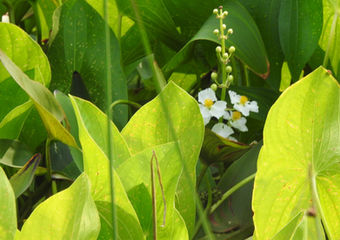Common Arrowhead
Common Name: Common Arrowhead.
Scientific Name: Sagittaria Latifolia.
What to look for? A green arrowhead-shaped leaf on top of a green stem emerging from the shallow, muddy waters. Look for colonies of these plants. The Common Arrowhead is a vigorous, aquatic perennial. It is noted for its arrowhead-shaped basal leaves and three-petaled white flowers in whorls of three. It commonly grows submerged in shallow water or out of water on wet muddy banks. Each flower has three white petals and either a cluster of yellow pollen-bearing stamens or numerous flattened pistils that will ripen into achenes, or fruits. This plant reproduces by reseeding itself or by forming clonal plants from the tuberous stolons.
Where can they be found at Carillon Stonegate Pond? Common Arrowheads can be found in the shallow waters of Carillon Stonegate Pond scattered amid the Pickerelweed. And you will find these on walks around our area where ponds or streams are quite muddy. Common Arrowheads can be seen off the creek that runs near Farnsworth and Indian Trail. In summer, you can find the Common Arrowhead’s white flowers in full bloom!
How big are they? Common Arrowheads are approximately one to three feet tall. The mature leaves are up to fourteen (14) inches long and up to ten (10) inches across – there is much variability in leaf size. The ascending petioles or leaf stalks are eighteen (18) inches long. Each flower is about one (1) inch long across.
Where do they grow and thrive? Common Arrowheads are native to sloughs, swamps, marshes and margins of streams and ponds throughout North America, including Illinois. These aquatic plants grow on muddy soils adjacent to receding shorelines of small ponds or creeks, or submerged in shallow, perennial water bodies. When growing underwater, the leaves often fail to develop the typical arrowhead-shaped or hastate leaf blades and consist instead of a grass-like leafstalk.
When do they bloom? The blooming period occurs from in summer from July through September.
Do birds, insects or other wildlife associate with this plant? The nectar and pollen of the Common Arrowhead’s flowers attract a variety of insects, including bees, wasps, flower flies, butterflies, skippers, and beetles. These insects cross-pollinate the flowers. Other insects feed destructively on the leaves, stalks, roots, and other parts of Common Arrowhead. Mallards and other ducks feed on their seeds and tubers; while muskrats feed on the stalk bases, crowns, and tubers.
Interesting Facts About the Common Arrowhead:
-
The Common Arrowhead is “monoecy” – flowers with separate sexes on the same individual plant - and is an adaptation to promote cross-fertilization. Although there are some populations that are “dioecious”, or single sex per plant. This is rare that a plant species could have both!
-
This plant reproduces by reseeding itself or by forming clonal plants from the tuberous stolons.
-
The tubers and seeds of this species are an important source of food to ducks.
-
The plant was once an important source of food for Native Americans, who harvested and consumed these tubers, and Wapato is one of the names given to it by the Cree.
-
The genus name comes from “sagitta”, Latin for arrow, referring to the shape of the leaves of some species.
-
After crossing half a continent and reaching the Pacific Ocean, the Lewis and Clark expedition spent the cold, dreary winter of 1805-06 cooped up at Fort Clatsop, near modern Astoria, Oregon and survived the winter on the starch-rich tuber of Common Arrowhead.
For more information on the Common Arrowhead and sources of information used in this blog (these are several of the sources that I am using to learn as I blog), please visit Illinois Wildflowers, Missouri Botanical Gardens, University of Texas Wildflower Center, Minnesota Wildflowers and Friends of the Wildflower Garden.
The Carillon at Stonegate community is very fortunate to have a variety of wetland, forest and prairie environments conducive to a variety of birds and other wildlife, insects and plants. Our community and the Kane County Forest Preserve do an exceptional job in maintaining this natural environment – both for the benefit of the birds and wildlife and for our residents to enjoy.
Take a hike and see what you can find – and identify!











